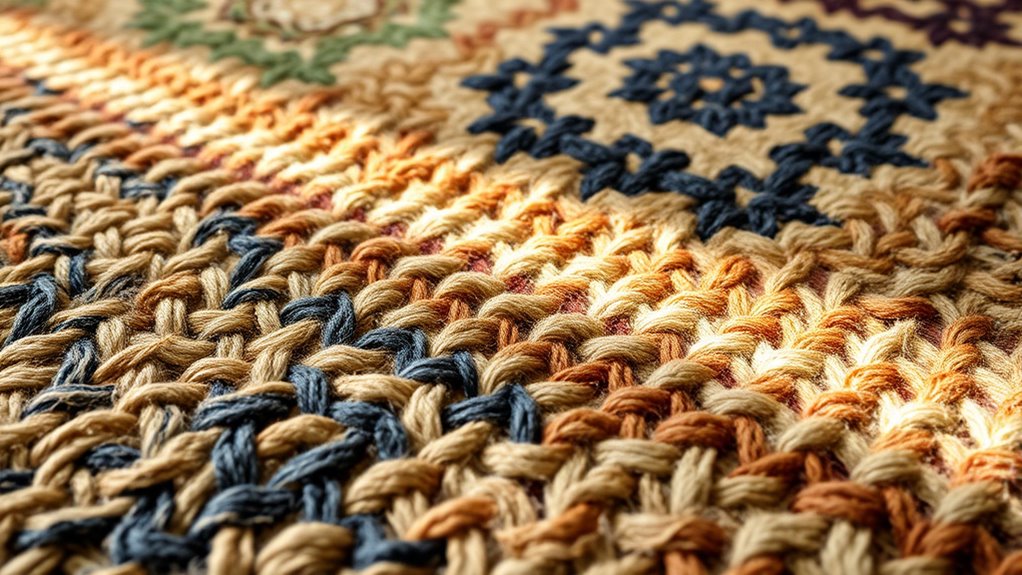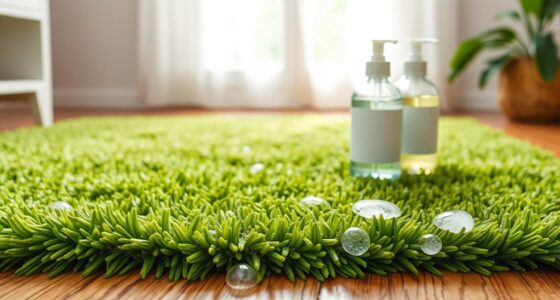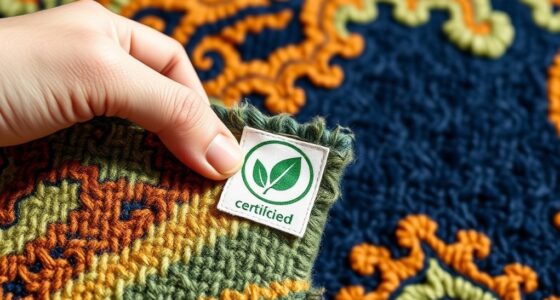Choosing sustainable rugs made from organic fibers like jute, wool, or organic cotton, paired with natural dyes, helps you create an eco-friendly home. These rugs use fewer chemicals, water, and energy during production, making them better for the environment. They support fair labor practices and local artisans while offering vibrant, long-lasting colors. By opting for these rugs, you align your decor with your values—exploring more about how eco-conscious choices can enhance your space.
Key Takeaways
- Sustainable rugs are crafted from renewable fibers like organic cotton, jute, sisal, and ethically sourced wool.
- Natural dyes derived from plants and minerals provide vibrant, eco-friendly colors that age beautifully.
- These rugs promote fair trade practices, ensuring ethical labor conditions and supporting artisan communities.
- They offer environmental benefits by reducing water, chemical, and energy consumption during production.
- Choosing sustainable rugs aligns home decor with eco-conscious values while supporting biodiversity and social responsibility.

Have you ever wondered how your choice of rug can impact the environment? The good news is, you can make a difference by opting for sustainable rugs crafted from eco friendly materials. These rugs are designed with the planet in mind, utilizing fibers that are renewable, biodegradable, and less harmful to our ecosystems. Materials like organic cotton, jute, sisal, and wool from ethically raised sheep are popular choices that reduce reliance on synthetic, petroleum-based fibers. By selecting rugs made from these eco friendly materials, you’re supporting a healthier environment, as they often require less water, fewer chemicals, and less energy during production compared to conventional fibers.
But sustainable choices go beyond just the fibers. Fair trade practices play a crucial role in ensuring that the people who make these rugs are treated fairly and work under safe conditions. When you purchase a rug produced under fair trade standards, you’re supporting ethical labor practices that empower artisans and communities. This means fair wages, safe working environments, and respect for traditional craftsmanship. By choosing fair trade rugs, you’re not just investing in a beautiful, luxurious piece for your home—you’re making a statement about your values and helping to promote social justice in the global supply chain.
The combination of eco friendly materials and fair trade practices results in rugs that are not only environmentally responsible but also socially conscious. These rugs often feature natural dyes derived from plants, minerals, or other organic sources, eliminating the need for toxic chemicals that can harm both workers and the environment. Natural dyes lend a rich, authentic look to the rugs, showcasing vibrant colors that age beautifully over time. This sustainable approach to dyeing not only reduces pollution but also ensures the longevity of the colors, keeping your rug looking stunning for years to come.
In addition, choosing sustainable rugs can help conserve biodiversity by reducing dependence on synthetic fibers derived from non-renewable resources. When you choose a sustainable rug, you’re making a conscious decision to support products that are better for the planet and the people who create them. It’s about investing in quality, durability, and ethical production, ensuring that your home’s aesthetics align with your values. These rugs serve as a reminder that luxury and sustainability can go hand in hand, allowing you to enjoy elegant, high-quality floorcoverings without compromising your commitment to environmental stewardship. So, next time you’re shopping for a rug, look for those made from eco friendly materials and certified fair trade practices—you’ll be making a positive impact with every step you take in your home.
Frequently Asked Questions
How Do Organic Fibers Compare in Durability to Synthetic Alternatives?
Organic fibers often have comparable durability to synthetic fiber durability, but their longevity depends on the specific material and usage. You’ll find that organic fibers like wool and jute can be quite resilient, especially when properly maintained. However, synthetic alternatives usually offer greater resistance to wear and moisture. If you want eco-friendly options with lasting appeal, choose organic fibers, but keep in mind their longevity may vary based on care and environment.
Are Natural Dyes Colorfast Over Time and With Cleaning?
Think of natural dyes as a delicate melody that can fade if not properly cared for. Yes, they offer beautiful, earthy tones, but their colorfast performance depends on the dyeing process and fiber type. When you maintain your rug with gentle cleaning, you extend its color’s life, ensuring its beauty endures. With proper care, natural dyes can retain their charm, providing cleaning longevity and a timeless, eco-friendly appeal to your space.
What Certifications Ensure the Sustainability of These Rugs?
You can guarantee the sustainability of these rugs by looking for certification standards like GOTS (Global Organic Textile Standard) and OEKO-TEX. These eco label verifications confirm that the rugs meet strict environmental and social criteria. When shopping, check for reputable labels to verify eco-friendly practices, organic fibers, and natural dyes, giving you confidence that your floorcoverings are both luxurious and sustainably produced.
Can Sustainable Rugs Be Customized in Size and Design?
You can definitely customize sustainable rugs in size and design. For example, a boutique hotel might work with artisans to create a large, bespoke rug featuring intricate, eco-friendly patterns. These rugs offer excellent customization options and design flexibility, allowing you to select dimensions and motifs that match your space perfectly. Many vendors now prioritize sustainable practices while providing tailored solutions, so you get both aesthetics and eco-consciousness in your unique floor covering.
How Should I Care for and Maintain Organic Fiber Rugs?
To care for your organic fiber rug, follow simple cleaning tips like vacuuming regularly to prevent dirt buildup. When stains occur, act quickly with gentle stain removal techniques, avoiding harsh chemicals that could damage natural fibers. Use a mild soap solution and blot gently, never rub. Protect your rug from excess moisture and direct sunlight to maintain its beauty, and consider professional cleaning for deep maintenance once a year.
Conclusion
By choosing sustainable rugs made from organic fibers and natural dyes, you’re not only elevating your space but also supporting eco-friendly practices. Did you know that the global demand for organic carpets has grown by over 25% in the past five years? This surge highlights how conscious consumers like you are making impactful choices. Embrace these luxurious, eco-conscious options, and contribute to a healthier planet—your home and the environment will thank you.









